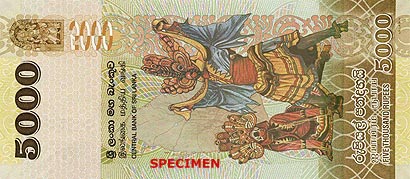Sri Lanka large bank note shows recent inflation: economist

A large denomination banknote issued by Sri Lanka’s monetary authority is a testament to the recent high inflation created in the country, an economist and opposition lawmaker has said.
Sri Lanka’s central bank issued a 5,000 rupee note, more than twice the value of 2,000 rupee, note also issued after the post-2004 inflation bubble in the country when fiscal probity was thrown out in favour of state expansion, deficit spending and money printing.
Harsha de Silva, an economist who is in Sri Lanka’s parliament representing the main opposition United National Party says inflation indicated by an official index was 111.6 points in April 2004.
“By January 2011, the CCPI had climbed to 231.2,” de Silva said in a statement.
“This means that the price level during this period has increased by 107 percent or more than doubled; said another way, the purchasing power of the Rupee has halved.”
De Silva says if one spent 2,415 rupees to buy some goods in 2004, the person will have to to spend 5,000 rupees to buy the same amount.
Sri Lanka issued a 1,000 rupee note in 1980 at a time when the country had the then highest inflation in its history.
The spike coincided with the so-called ‘second oil shock’ and commodity bubble which the US Federal Reserve chief Paul Volcker broke with 18.0 percent interest rates.
Sri Lanka’s rupee is pegged to the US dollar and the currency is de facto ‘externally anchored’ to US price levels which roughly sets a floor for inflation to which the domestic central bank adds with its own money printing.
During the 2008 commodity bubble Sri Lanka’s inflation hit 29.9 percent and the state changed the inflation index.
High levels of inflation are caused by paper ‘fiat’ money central banks. Under a gold standard for monetary policy there was no sustained global inflation. The dollar for example was about 20 US dollars an ounce from 1792 until the creation of the Federal Reserve.
The Fed devalued its paper to 35 dollars an ounce within 20 years of its creation. Now gold is about 1,300 US dollars an ounce. World Bank chief Robert Zoellick has called for a return to gold linked money to reign in central banks.
Sri Lanka stated to suffer high inflation and foreign currency shortages after 1950 when a money printing central bank was created by a United National Party led administration abolishing a currency board (hard peg) arrangement that kept the economy stable during colonial rule.
The 5,000 rupee note was officially issued on February 04, which marks the end of colonial rule.
Source: Lanka Business Online

Latest Headlines in Sri Lanka
- Batalanda commission report tabled in Sri Lankan Parliament March 14, 2025
- Female Grama Niladharis withdraw from night duty over security concerns March 14, 2025
- Sri Lanka ranked as the best country for settling down March 14, 2025
- UN pledges support for Sri Lanka’s industrial and SME development March 13, 2025
- Former Boossa Prison Superintendent shot dead in Akmeemana March 13, 2025



The large bank note (Rs. 5000) shows the inflation of Sri Lanka. Japan has 10,000 notes. Does it mean Japan has high inflation.
Mohamed Shareef Asees